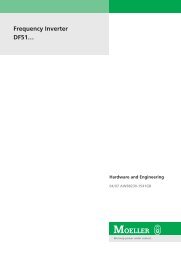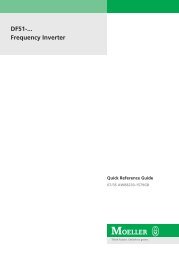Hardware and Engineering DF6-340-... Frequency ... - Moeller.com.tr
Hardware and Engineering DF6-340-... Frequency ... - Moeller.com.tr
Hardware and Engineering DF6-340-... Frequency ... - Moeller.com.tr
Create successful ePaper yourself
Turn your PDF publications into a flip-book with our unique Google optimized e-Paper software.
01/02 AWB8230-1413GB8 TroubleshootingFault Condition Possible cause RemedyThe motor will notstart.The motor turns inthe wrong direction.The motor will notstart.There is voltagepresent at outputs U,V <s<strong>tr</strong>ong>and</s<strong>tr</strong>ong> W.There is voltagepresent at outputs U,V <s<strong>tr</strong>ong>and</s<strong>tr</strong>ong> W.Is voltage applied to terminalsL1terminals L1, L2<s<strong>tr</strong>ong>and</s<strong>tr</strong>ong> L3?If yes, is the ON lamp lit?Does the LED display on the keypad indicate afault (E……) an?Has a start signal been issued?Has a frequency setpoint value been enteredunder PNU F001 (keypad operation only)?Are the setpoint definitions through thepotentiometer correctly wired to terminals H, O<s<strong>tr</strong>ong>and</s<strong>tr</strong>ong> L?Are inputs O, , O2 <s<strong>tr</strong>ong>and</s<strong>tr</strong>ong>/or OI correctly connectedfor external setpoint definition?Are the digital inputs configured as RST or FRSstill active?Has the correct source for the frequency setpoint(PNU A001) been set?Has the correct source for the start <s<strong>tr</strong>ong>com</s<strong>tr</strong>ong>m<s<strong>tr</strong>ong>and</s<strong>tr</strong>ong>(PNU A002) been set?Is the motor blocked or is the motor load toohigh?– Are output terminals U, V <s<strong>tr</strong>ong>and</s<strong>tr</strong>ong> W correctlyconnected? Does the connection of terminals U, V<s<strong>tr</strong>ong>and</s<strong>tr</strong>ong> W correspond with the direction of rotationof the motor?Are the con<strong>tr</strong>ol signal terminals correctly wired?Has PNU F004 been configured correctly?– A setpoint value is not present on terminal O O,O2 <s<strong>tr</strong>ong>and</s<strong>tr</strong>ong>/or OI.Is a fixed frequency accessed?Is the motor load too high?Check terminals L1, L2, L3 <s<strong>tr</strong>ong>and</s<strong>tr</strong>ong> U, V, W. Switchon the supply voltage.Analyze the cause of the fault signal (a section“Messages”, page 151). Acknowledge the faultmessage with the reset <s<strong>tr</strong>ong>com</s<strong>tr</strong>ong>m<s<strong>tr</strong>ong>and</s<strong>tr</strong>ong> (e.g. bypressing the OFF key).Issue the start signal with the ON key or throughthe FWD/REV input.Enter a frequency setpoint value underPNU F001.Check that the setpoint signal is correctlyconnected.Check that the setpoint signal is correctlyconnected.Deactivate RST <s<strong>tr</strong>ong>and</s<strong>tr</strong>ong>/or FRS.Check the signal on digital input 1 (defaultsetting: RST).Correct PNU A01.Correct PNU A02. (a section “Setting thefrequency <s<strong>tr</strong>ong>and</s<strong>tr</strong>ong> start signal parameters”,page 107)Reduce the load acting on the motor. Test themotor without load.Connect output terminals U, V <s<strong>tr</strong>ong>and</s<strong>tr</strong>ong> W correctly tothe motor according to the required direction ofmotor rotation (generally the sequence U, V, Wcauses clockwise operation).Use con<strong>tr</strong>ol signal terminal FW(D) for clockwiserotation, REV for anticlockwise rotation.Under PNU F004, enter the required direction ofrotation.Check the potentiometer or the external setpointgenerator <s<strong>tr</strong>ong>and</s<strong>tr</strong>ong> replace if necessary.Observe the sequence of priority: the fixedfrequencies always have priority over the inputsO, O2 <s<strong>tr</strong>ong>and</s<strong>tr</strong>ong> OI.Reduce the motor load as the overload limit willprevent the motor reaching its normal speed ifthere is an overload.157







